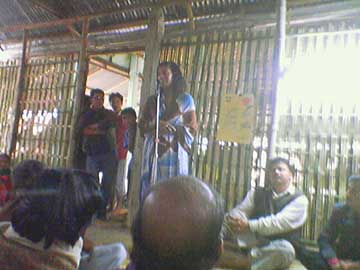
Boron Dahanir Ela (Rain Invoking Songs, বরন ডাহানির এলা) is the most renowned ancient folk song in Bishnbupriya Manipuri, which has been handed down through oral tradition. This song was composed at a time, when the story of the epic became very popular. The song is addreesed to Soralel, the king of Gods.It is believed that this song is endowed with the power of calling-forth rain. Accordingly, in times of dearth, this song is sung at night in chorus by males and females with a view to calling forth rain.
These songs are composed in Medieval Bishnupriya Manipuri Language, 1450 A.D.
1.
Soralelelete rajaro leipak kumou koilo
liepake marai makhonge khoimure jangal dilo
khumolor mati hukeilo boron diyade douraja
lukong mahei lukulil boron diyade douraja
English Rendering: O Saralel, the King of the gods, the land of the Khumals has become sandy because of dearth. Khaimu is making a dam with grass and other things. O King of the gods, the land of the Khumals has dried up i pray, send us rain.
2.
Horio ramo leimelte kunggoi pit kore
leimel mana nungsipa donlo loya benur ate dilo
rabonor puto birbau birbare bukor dhian koilo
bukor dhian korernai losmone phulor leirang dilo
leikeiro kalaro dahiau dei kadiau kheinaro
English Rendering: O Rama, who will eat and drink in this sorrowfully condition ? I have given an offering of all my joys and, sorrows together with wealth to Benu (Pahampa), just as, Birabao, the son of Rabal(Ravana) Practised penance ( as a result of which ) lasman favoured him with flowers. O Kala, living in the neighbourhood, please call other and offer, please weep together and eat.
3.
Tampharo aparo horeigo dole dumeye yeichil koilo
hilong lalong e hilro sora gongai laloiliye
najeiga ghate buliyaho karong leimai doriya thameilo
habi dou e huno moirang pachai nahunoka nungsiye hoyo
monjar khanir tolete sirio ramo gurure lekhat doilo
English Rendering: O Father Tamphi, Dumei has consulted astrology (and has visualised that) Gahga is rushing down through mountain tribulets, but Karanga, the daughter of Pahangpa, bars the on-rush. May all the gods realise our condition, but Moirang-shouId not hear about it.
4.
Antara giriro jilok yeimapire antara
tampake huna peitega leilenge huna chaore
leitenge hirire mengko koilo
jomjomade jeiriga doner koirengore
English Rendering: Astrologers say that the rainlessness has been caused by Pahangpa, who is angry because of the insult shown to Chamel by the King. They advise the people to bring Chamei and Beti back to the kingdom. The second daughter of Giri (Beti) is being brought. When she reaches the vast field. she is welcome with various auspicious things and, consequently, she proceeds gorgeously like the God of Wealth (Kuvera).
5.
Phijapina langjapi madoi wang khele
madoi wang khele ho hunar langchak beror jalat thoile
ailide bela eilinai, denu moire bela beilonai
hoibanar matao nuarlo, chinchi nanchak diao nueilo
English Rendering: O Midai, a woman, has suspended her weaving and speaks of Beti. Bela comes and speaks ill of Denu.
6.
Chomeio beti thokurare
kohonilo dore dibangta jonom aro
kala kala angara dola dola lengoulo hoyo
donete chari chilalo Pahangpai bario nadilo
English Rendering: Chamei is hesitating to come. The women are ,abusing him, and the angry old persons tell them to welcome him with coal and sand, instead of incense. It is his good luck,, they say, that though he is very poor, Pahangpa has not punished him.
7.
Choha jura bado senarei pidia naso
Choha jura dabo ho Moirang e leirir tole homeil
Hiliri bilor pohon chakauda kene alojarga
borbilor dola touthara nalade lusu boheila
English Rendering: Rain is coming gradually. Pahangpa is also glad and is coming over the big lake(Loktak). Women are glad and are proposing to dance with their hair locked and with flowers in their ears.
8.
Nalade lusu boheila, garbage solut doreila
kala chingkheir borone kmne tala nanluga
udai dilo tingla tala pahuri gore beli ailu
batiye ali karere maje khongneme
muthi muka cheiluta sena changninge
kochur pata na bader liksaro sena moichamre
Pahangpai bokor henou maglo
bokor henou karirina, Pahangpai chone hodabello
Deinai dilo donukhan chirtei nachirer
uthanro agar bekurinai dorteo nadorer
English Rendering: Rain is falling cats and dogs, and persons are catching fiihes from the canals with various instruments. Persons are out to catch fish before dawn. They have forgotten to ,bring umbrellas offered by their friends. Some are tying the rice-plants. into bundles, in which silvery water-drops are seen. The leaves of arum cannot bold the rain-water. The people cannot return home owing to heavy rain. They are anxious to return home and pay offerings of mango demanded by Pahangpa, but the rain does not stop.
Summury of the Rain Invoking Song
A Khumal King was defeated by a Moirang King, several times. Once more, he wanted to try his fortune and proposed in his ministerial council to attack the Moirang kingdom. His younger brother Cha mei objected to this, where for the enraged King insulted him and ousted him from the meeting hall. Chamei, thus insul ted ,left kingdom alone. Seeing him thus leaving, a maid-servant (beti) followed him with a few clothes for him. When the prince noticed her, he asked her to go back. But as they, were by then far from human habitation, it was not possible for her to go back. The prince, followed by the maid-servant,, reached the Kabru hill where he was cordially received by the Kukis. After a span of time, Chamei had an issue through, the maid-servant. Gradually, three years passed away. During this period, there was no rain in the Khumal kingdom, as a result of which a severe famine came upon the land.
SOURCE AND REFERENCE :
DR. K.P SINHA, THE BISHNUPRIYA MANIPURIS, CALCUTTA, 1984
Bangla Version: ষোড়শ শতকের একটি বিষ্ণুপ্রিয়া মণিপুরী বৃষ্টি ডাকার গান ও তার বাংলা অনুবাদ


